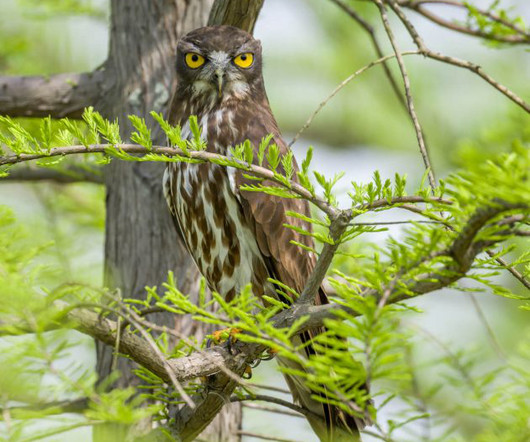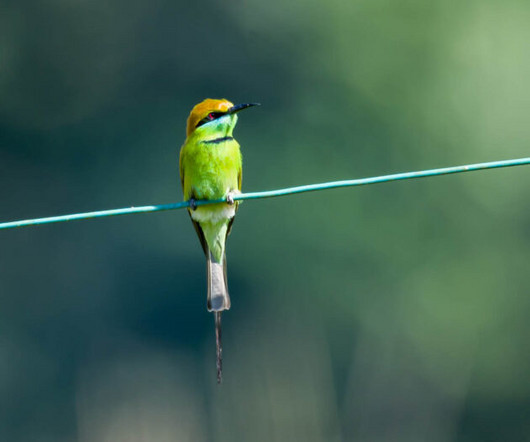A Hunting Snowy Egret
10,000 Birds
AUGUST 11, 2012
The egret used two different hunting strategies. It was odd to watch a single bird use such drastically different hunting styles and I really don’t have an explanation as to why.
This site uses cookies to improve your experience. To help us insure we adhere to various privacy regulations, please select your country/region of residence. If you do not select a country, we will assume you are from the United States. Select your Cookie Settings or view our Privacy Policy and Terms of Use.
Cookies and similar technologies are used on this website for proper function of the website, for tracking performance analytics and for marketing purposes. We and some of our third-party providers may use cookie data for various purposes. Please review the cookie settings below and choose your preference.
Used for the proper function of the website
Used for monitoring website traffic and interactions
Cookies and similar technologies are used on this website for proper function of the website, for tracking performance analytics and for marketing purposes. We and some of our third-party providers may use cookie data for various purposes. Please review the cookie settings below and choose your preference.

10,000 Birds
JULY 17, 2013
The Migratory Bird Hunting Stamp Act , which went into effect seventy-nine years ago on July 1, 1934, authorized the annual issuance of what is popularly known as the Duck Stamp. In 1976, Congress changed the official name to the Migratory Bird Hunting and Conservation Stamp , presumably to broaden its appeal to non-hunters.
This site is protected by reCAPTCHA and the Google Privacy Policy and Terms of Service apply.

10,000 Birds
JANUARY 15, 2013
Now and then individual catfish of various species hunt nearer the surface and larger catfish such as the American Channel Cat will take a duck or other water bird. So, the modal catfish is a fish that hunts from below, can take large prey, and occasionally eats a bird. Here is a video of some Wels Catfish foraging on Pigeons.

10,000 Birds
JUNE 5, 2012
Typically these birds hunt at night and are very shy. One of only three true fishing owls, Pel’s Fishing Owls have adapted to their unique hunting techniques in several ways. We crossed a small bridge in the landrover and that’s when I saw it. In full sunlight, at eye-level and eating a freshly caught fish.

10,000 Birds
SEPTEMBER 9, 2011
Flickers have other strategies. But the all-time favorite flicker strategy is to scream like a slasher movie victim and fly straight at the person’s head. But the all-time favorite flicker strategy is to scream like a slasher movie victim and fly straight at the person’s head.

10,000 Birds
JULY 20, 2012
But the honeyguides, indigobirds, and a single species of duck all do the classic cuckoo strategy (obligate interspecific brood parasitism) as well. This behavior is most common in colony nesters, since popping next door to drop off an egg is a lot easier than hunting down another nest through acres of forest or grassland. But come on.

10,000 Birds
APRIL 26, 2013
Although if you want to see a bunch of Turkey Vultures it’s a pretty good strategy. Lest you think that modern technology robbed all the challenge from my hunt, though, I would point out that there were a couple of confounding factors. And who doesn’t want to see a bunch of Turkey Vultures?)

10,000 Birds
JULY 18, 2013
They’re unusual to be sure, but there’s a certain grace in the back and forth monotony of the spoonbill’s feeding strategy and there’s little like seeing a line of spoonbills tearing across a shallow mudflat seeking food you can’t possibly see. Roseate Spoonbill , photo by Julie Gidwitz.

10,000 Birds
SEPTEMBER 11, 2022
The area is used as a hunting ground for large raptors including the White-bellied Sea-Eagle and Brahminy Kite. We are hopeful that this strategy of roosting amongst so many other birds may have advantages and help in the survival of the juvenile Pied Oystercatchers.

10,000 Birds
APRIL 21, 2016
There were five issues and recommendations of the group: Issue 1: The conservation benefits of the Duck Stamp are poorly understood among the wildlife viewing community and the public, as well as among much of the hunting community. a) Recommendation : Identify new (non-hunting/recreational) uses for the Duck Stamp.

10,000 Birds
APRIL 6, 2021
Great Frigatebirds engage in “unihemispheric sleep” on hunting trips of six to ten days, never landing, sleeping less than an hour in a 24-hour cycle, often keeping one-half of their brain awake while the other slept. Pause while we all try to imagine what our lives would be like if we could do that.)

Sales and Marketing Management
APRIL 17, 2016
Author: Tom Searcy, CEO of Hunt Big Sales. We review some potential roadblocks that often complicate sales leadership efforts, as well as three corresponding cleanup strategies to try. We review some potential roadblocks that often complicate sales leadership efforts, as well as three corresponding cleanup strategies to try.

10,000 Birds
FEBRUARY 5, 2013
The chapter on Turning the Tide is happier, if much briefer, focusing on the Commission’s strategy of recognizing wetlands as a natural resource, working with the Department of Environmental Protection to de-pollute the Hackensack River, and restoring many of the wetland areas. This really happened, we created a landscape of toxic horror.

SalesFuel
APRIL 2, 2024
Inviting prospects to strategy sessions with subject-matter experts,” can be a way to demonstrate concern about positive outcomes. In addition, our research confirms that buyers are hunting for solutions and industry thought leaders long before they reach out to a company.

Sales and Marketing Management
DECEMBER 15, 2017
Like deploying a gadget play or the play-action pass, innovations in strategy and technology are often decisive in winning the game. Regardless of your organization’s size, stage or current position on the B2B playing field, the key to victory is knowing your strategy. Here are four ways to hack your B2B growth with AI. .

Sales and Marketing Management
OCTOBER 27, 2020
Everyone is online or social media hunting for the same leads. Solution – Salespeople need great strategies to stand out, and must incorporate the benefits seen from using CRM. Fear of not finding enough leads.

Sales and Marketing Management
MARCH 11, 2018
Author: Vaughn Aust Defining leads that matter is key to any sales and marketing strategy, but how do you pinpoint those golden customers? Sales and marketing teams are usually on the hunt for high-potential, high-revenue leads—but don’t overlook high-potential, low-revenue leads. Open New Sales Channels and New Lines of Revenue.

Sales and Marketing Management
JUNE 28, 2017
However, a lot has changed in the business world since 1992, and a different kind of sales strategy has emerged – one that can help you close more deals AND benefit your organization as a whole: ABC.Always Be Collaborating. Coming together is the beginning, keeping together is progress.

SalesFuel
FEBRUARY 24, 2025
Get ready to turbocharge your sales strategy with the top 21 sales intelligence tools that will make waves in 2025. LinkedIn Sales Navigator If building strong relationships is your sales strategy, then LinkedIn Sales Navigator is the secret to your success. For outbound sales pros, Seamless.AI <H3> 15.

Sales and Marketing Management
JUNE 28, 2017
However, a lot has changed in the business world since 1992, and a different kind of sales strategy has emerged – one that can help you close more deals AND benefit your organization as a whole: ABC.Always Be Collaborating. Coming together is the beginning, keeping together is progress.

10,000 Birds
MARCH 6, 2023
Shockingly, the Ashy-throated Parrotbill apparently is a species heavily hunted for bird fighting in Guizhou Province, China ( source ). If being hunted by evil humans was not enough, Ashy-throated Parrotbills are also hosts of the parasitic Common Cuckoo. Shame on the researchers.

10,000 Birds
JANUARY 20, 2015
Soon after carnivores that could hunt on land evolved, things like ancestral centipedes. For a long time the plants were mostly left untouched but their dead leaves and protoleaves were consumed by things like ancestral millipedes.

10,000 Birds
NOVEMBER 1, 2016
Thankfully, as the authors note, this focus on animals to hunt has given way to visitors’ fascination with a range of creatures.). (The Big Five–Lion, Leopard, African Buffalo, African Elephant and Rhinoceros–were historically the main mammal attraction of Kruger.

10,000 Birds
SEPTEMBER 4, 2017
One of the black-crowns and the Green Heron were clearly in hunting mode, leaning over the water, staring intently. Here’s a Green Heron just a few yards up the creek from back in July, hunting with the same strategy. a hungry Green Heron. But why had these herons chosen this particular spot to go fishing?

10,000 Birds
DECEMBER 4, 2015
Lead remains in both fishing and hunting products, with strong lobbies that insist lead poisoning is not real, even as our facilities fill regularly with birds afflicted with it. Respect, understanding, and a greater awareness of wildlife are key for the public and agencies alike.

Sales and Marketing Management
JULY 3, 2017
Another problem we’ve seen is that sales organizations often stumble with their strategies. You might start off with a program targeting the smaller end of small businesses and then partway through you decide, “Hey, let’s go hunt for mid-market and larger enterprises.” You know who to cross-sell and upsell with your sales efforts.

10,000 Birds
FEBRUARY 4, 2013
I’m fairly certain that it was the deliberate strategy of the bird to kill the duck on the water and wait for it to come ashore. This bird was “tamer” than most of her species because she had become accustomed to hunting the narrow causeway for ducks and was relatively acclimated to all the vehicular traffic.

10,000 Birds
SEPTEMBER 3, 2014
On the shore were the dominant big birds you see in Australia, a very vocal Australian Raven , some Australian Magpies , a hunting Grey Butcherbird , pairs of Maned Ducks cropping the grass and a pair of Laughing Kookaburras watchfully surveying the cafe patrons. Dusky Moorhen The Maned Duck – or Australian Wood Duck. A Rose Robin.

10,000 Birds
JUNE 19, 2012
Watching them hunt is fascinating. Another strategy regularly employed by these weird raptors is that they will soar great distances, utilizing thermals in search of bush-fires. We stayed with the larger bird as it settled down to the serious business of hunting. But another reason might be that the wing flares confuse the prey.

10,000 Birds
DECEMBER 30, 2020
Common Cuckoo is a fascinating bird, an obligate parasitic breeder that employs numerous strategies, including fraud and murder, to survive. , deep-pandemic birds (all local), and still-pandemic birds (a little travel), it is the Rhode Island Common Cuckoo that will define this year for me. I saw the Cuckoo the second day of its visit.

10,000 Birds
APRIL 15, 2015
Now that the colony is off limits for hunting, the population has grown and the village is benefitting tremendously from entry and guide fees, and a school is being built courtesy of conservation funds. Another of Ghana’s forest gems, the seldom encountered Fraser’s Eagle Owl. .

SalesFuel
FEBRUARY 25, 2025
The hunt for the perfect market intelligence data tools can be overwhelming, but fear not! Stay competitive by providing key advantages such as: Competitive edge : Monitoring competitor activity helps businesses anticipate shifts in the market and adjust their strategies before losing ground.

SalesFuel
APRIL 22, 2025
As they hunt for great candidates, managers know the rest of the staff is picking up extra tasks to ensure that the workflow continues. This strategy can save organizations money. Organizations can drastically reduce hiring costs and mistakes by using assessments. Other times, managers worry about budget allocations.

SalesFuel
NOVEMBER 24, 2024
Businesses must anticipate market twists and turns, sniff out competitor strategies, and respond swiftly to stay relevant. After decades of fine-tuning sales strategy, SalesFuel used its hard-won knowledge to create SalesCred, which offers individualized insights, solid pre-call prep, and tactics to hone sales skills.

Sales and Marketing Management
JANUARY 29, 2018
I always knew networking was a great avenue to develop business, but I never thought it could be nearly your entire sales strategy. Networking is farming, not hunting. They are implied endorsements of someone’s quality and credibility. At one point, I visited 17 different BNI chapter meetings in one month, all of which met at 7 a.m.

10,000 Birds
NOVEMBER 7, 2017
Hunting: You may have noticed that the Written Species Accounts include a section on hunting. I am a city girl and until I became a birder my contact with hunting was limited to occasionally seeing dead deer on the tops of cars in upstate New York. So–not a fan of hunting. I was really taken aback when I saw this.

10,000 Birds
MAY 1, 2023
To be honest, both the robin and the flycatchers shown above remind me of the easter eggs I hunted for as a child – the same strong colors in front of a green background, same time of the year (feel free to insert your own Proust Madeleine reference here) … Bluethroats apparently are good at imitating other birds.

10,000 Birds
JANUARY 29, 2024
” Blue-bearded Bee-eaters seem to have a pretty clever hunting strategy. The authors of the paper sound a bit helpless, stating that “At the time of discovery, both birds [two bee-eaters] were still alive, but it was not possible to free them from the net because the bees began to attack the ringer.”
Expert insights. Personalized for you.
We have resent the email to
Are you sure you want to cancel your subscriptions?


Let's personalize your content